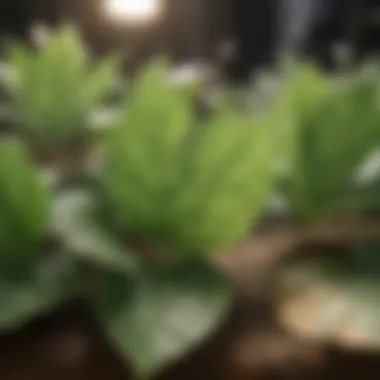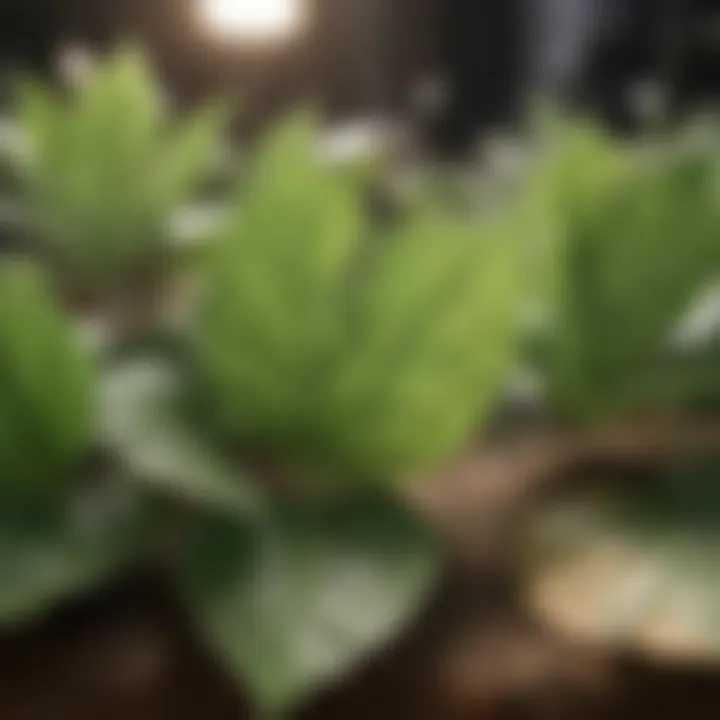Exploring Leaf Structure, Function, and Ecology


Intro
Exploring the intricacies of leaf form opens a window into the wonders of botany. Leaves are more than just the green fronds adorning trees; they are essential components of plant life that play a pivotal role in photosynthesis and the overall health of ecosystems. The structure of leaves varies immensely across different species, from broad and flat to needle-like forms, and each variation serves a particular function. This section aims to highlight the importance of understanding leaf morphology and the ecological implications it entails.
Recent Advances
Latest Discoveries
Recent studies have illuminated the connection between leaf structure and environmental adaptation. Research has showcased how plants in arid regions develop thicker leaves to conserve water while those in areas with abundant moisture might evolve larger surface areas to maximize sunlight absorption. For instance, a study conducted in the deserts of Arizona revealed that certain cacti exhibit fleshy leaves that retain moisture, enabling them to thrive in extreme conditions.
Furthermore, understanding the genetic basis of leaf morphology has seen notable progress. Scientists have identified specific genes responsible for various leaf shapes, thereby elucidating how plants diversify in form based on their habitats. These advances not only deepen our comprehension of plant biology but also offer insights into how plants might adapt to changing climates.
Technological Innovations
The integration of technology in botanical research has revolutionized our approach to studying leaves. High-resolution imaging techniques, such as X-ray computed tomography, allow researchers to visualize the internal structures of leaves without damaging them. This has facilitated a better understanding of how different architectural designs contribute to functionality.
Remote sensing technologies have also proven beneficial. They enable scientists to monitor leaf health and response to environmental stresses on a large scale, providing data that can inform conservation efforts and agricultural practices.
"In the realm of plants, the leaf is not just an appendage; it is a microcosm of evolution itself. Each leaf tells a story of survival, adaptation, and interaction with the environment."
Methodology
Research Design
To investigate the multifaceted roles of leaf structure and function, a combination of comparative and experimental methodologies has been employed. Comparative studies analyze leaf form across various species and habitats, while experimental designs test specific hypotheses regarding how structural variations affect physiological processes.
Data Collection Techniques
Researchers utilize diverse techniques for data collection, including:
- Field Studies: Observe and document leaf morphologies in situ across various environments.
- Laboratory Analysis: Employ controlled experiments to measure photosynthetic efficiency under different light and water conditions.
- Genomic Techniques: Sequence DNA to identify genetic variations linked to leaf traits.
This multifaceted approach ensures a comprehensive understanding of leaf morphology and its broader ecological implications.
Prelude to Leaf Form
Leaves, the hardworking appendages of plants, play a crucial role in their overall vitality, adapting to various environments while performing essential functions. When we dive into the concept of leaf form, we encounter a vast world of intricate structures that highlight the resilience and versatility of plant life. By understanding leaf form, we begin to appreciate not just the aesthetics of foliage but the profound significance it holds in ecological systems.
Definition of Leaf Form
At its core, leaf form refers to the various shapes, sizes, and structures that leaves can assume. This encompasses everything from broadleaf varieties, like those found in fig trees, which exhibit wide, flat surfaces, to narrowleaf types like those on pines, which are optimized for specific conditions. Leaf form is more than a mere biological trait; it embodies the evolutionary strategies plants employ to thrive in diverse habitats. With parameters like leaf length, width, and overall surface area coming into play, definitions can vary widely based on species and their respective ecological contexts.
It's noteworthy to point out that leaf morphology isn't static. It evolves; responses to environmental stimuli contribute to shaping these forms. For instance, leaves may undergo adaptation changes during periods of drought, manifesting in thinner shapes or a waxy coating to prevent water loss. Understanding leaf form helps unravel the complex interaction between plants and their habitats, and reveals the strategies they utilize to cope with challenges.
Importance in Plant Biology
The significance of leaf form stretches far beyond tinkering with the visual appeal of a garden or forest. In plant biology, leaves are the primary organs responsible for photosynthesis, the process whereby plants convert sunlight into energy. This means that the efficiency of leaf form directly correlates with a plant's ability to harness sunlight and synthesize food. Variations in leaf form can lead to differences in photosynthetic efficiency, which is crucial for survival, especially in competitive environments.
Moreover, leaf form also holds implications for other processes, such as water retention and herbivory resistance. Take the broad, flat leaves of a tropical plant — they might capture more sunlight but also risk higher water loss due to their surface area. Conversely, smaller or needle-like leaves might retain moisture better but limit the capacity for photosynthesis. Thus, the relationship between leaf form and plant health is intricate, warranting detailed exploration.
"The shape and structure of leaves are not just aesthetic choices of nature; they illustrate the plant's battle for survival amid competing demands of sunlight, water, and nutrients."
From the broad reaches of the Amazon rainforest to the arid landscapes of the Sahara, the importance of leaf form is vividly displayed. Each leaf design serves a purpose tailored to specific environmental conditions and biological necessities, emphasizing the elegance and intelligence inherent in plant biology.
Morphological Characteristics of Leaves
Understanding the morphological characteristics of leaves is crucial for grasping how plants adapt to their environments, how they function, and their overall ecological roles. Leaves are not merely passive structures; they are dynamic organs that reflect a plant's evolutionary strategies. The diverse shapes, sizes, and arrangements of leaves contribute significantly to processes like photosynthesis, water conservation, and even plant defense mechanisms. By exploring these characteristics, we can glean insights into how different plants thrive or struggle in varying conditions.
Types of Leaf Shapes
Broadleaf


Broadleaf plants are distinguished by their wide, flat leaves that often have a significant surface area. These leaves play a pivotal role in maximizing light capture, which is essential for effective photosynthesis. The broad shape allows for greater exposure to sunlight, making them particularly advantageous in environments with ample light. A notable feature of broadleaf plants is their tendency to lose leaves in the fall, a strategy that helps conserve water during the dryer months. Their effective light interception comes at a cost, though; they are more prone to herbivory due to their size and soft tissues, thus necessitating some form of defense.
Narrowleaf
Narrowleaf plants, those equipped with long and slender leaves, present a very different strategy. The key characteristic of narrowleaf leaves is their reduced area, which significantly minimizes water loss through transpiration. This adaptation is primarily beneficial in arid or windy environments where water conservation is necessary. A unique aspect of narrowleaf design is the vertical orientation that often accompanies their form, allowing them to dodge excess sunlight, reducing overheating risk. However, while their design helps them endure harsher climates, their light capture efficiency may not match their broadleaf counterparts.
Compound Leaves
Compound leaves consist of several leaflets attached to a single stem, which can be advantageous in several ways. This structure can decrease the wind resistance that a single broad leaf might face, reducing the likelihood of damage in stormy conditions. A significant feature of compound leaves is their flexibility and the ability to maneuver in response to wind and other environmental factors. However, their complexity can also lead to a higher cost of investment for the plant, as developing multiple leaflets requires more resources.
Simple Leaves
Simple leaves, characterized by a single, undivided blade, offer distinct advantages too. These structures are often easier to produce and maintain, making them quite efficient for many plants. A notable feature of simple leaves is their straightforward approach to photosynthesis without the complexity of multiple divisions. Their effectiveness in sunlight capture is prevalent in many temperate regions, although they can be more susceptible to damage in harsh conditions compared to more robust designs like compound leaves, leading to a potentially higher risk in areas facing severe weather.
Leaf Venation Patterns
Parallel Venation
Parallel venation is typified by veins that run in straight lines alongside each other, a feature commonly seen in monocotyledons like grasses. This pattern contributes to structural strength, enabling leaves to withstand stress from wind or rain while providing a clear path for water and nutrients. The arrangement is efficient for quick nutrient transportation but can limit flexibility, leading to some disadvantage during severe weather.
Net Venation
On the other hand, net venation features a branching pattern that resembles a network. This design is often found in dicotyledons such as oak trees. It allows for a more intricate nutrient distribution system while also enhancing the leaf’s overall strength. The downside is that while it maximizes light absorption, it may require more resources to sustain, leading to greater energy investment by the plant.
Surface Structure
Cuticle Layer
The cuticle layer is a waxy film covering the outer surface of leaves, playing an essential role in preventing water loss. It acts as a barrier against excessive evaporation, making it particularly beneficial in arid environments where water conservation is critical. A well-developed cuticle provides an advantage for plants by shielding them from environmental stressors, though it may limit gas exchange, potentially affecting photosynthetic efficiency.
Trichomes and Stomata
Trichomes are tiny hair-like structures that can be found on leaf surfaces, offering protection against herbivores and environmental stress such as high temperatures. They can trap moisture and create a microclimate around the leaf, which can also enhance water retention. Meanwhile, stomata are pores that allow for gas exchange, crucial for photosynthesis and respiration. The challenge lies in balancing the presence of trichomes and stomata, as an increase in one can lead to a decrease in the other, affecting the plant’s efficiency in photosynthesis and water use.
Functional Significance of Leaf Form
Understanding the functional significance of leaf form is paramount in deciphering how plants adapt to their environments and sustain life on Earth. Leaves serve as the primary site of photosynthesis, where sunlight is harnessed and converted into chemical energy. Beyond mere energy production, the unique structures of leaves influence water usage, herbivory resistance, and overall plant health. By examining these functions one by one, we can appreciate the critical roles that various leaf forms play in ecological systems.
Photosynthetic Efficiency
Light Absorption
Light absorption is a fundamental process for any plant, as it transforms solar energy into the chemical energy required for growth and reproduction. Leaves come in different shapes and sizes to optimize this process. For instance, broad leaves are typically more efficient at capturing sunlight than smaller, narrow leaves, allowing plants to maximize light energy in low-light environments such as forests.
A key characteristic of light absorption is the presence of chlorophyll, the pigment that gives leaves their green color. This pigment captures red and blue light wavelengths effectively. In shaded environments, leaves can adapt by having a higher chlorophyll concentration to increase absorption rates. Therefore, efficient light absorption is essential, particularly for understory plants in dense forests, as they often compete for limited light.
One unique advantage of effective light absorption is its role in supporting not just individual plants, but entire ecosystems. When plants efficiently convert light into energy, they become foundational to food webs, sustaining herbivores and, consequently, the predators that rely on them.
Gas Exchange Mechanisms
Gas exchange mechanisms operate through stomata—tiny openings on the surfaces of leaves that regulate the intake of carbon dioxide and the release of oxygen. This process not only fuels photosynthesis but also influences transpiration, where water vapor exits the leaf. An important factor here is the dynamic balance stomata maintain—it’s all about getting the right amount of CO2 while conserving water, especially in dry conditions.
The unique feature of these gas exchange mechanisms lies in their ability to adapt to environmental conditions. Stomata can open and close in response to moisture levels, temperature changes, and the plant's overall water needs. This adaptability makes stomatal regulation a beneficial trait for plants in fluctuating climates, enabling them to optimize photosynthesis while reducing water loss.
Water Retention Strategies
Leaf Size and Shape Relationships
The size and shape of leaves can significantly impact water retention. For example, smaller leaves or those with a waxy cuticle minimize evaporation. Many desert plants exhibit this trait, as they have adapted to conserve water in arid conditions. In contrast, larger leaves may be seen in tropical regions, where rainfall is abundant and evaporation rates are high.
A key characteristic to note is the relationship between leaf shape and surface area-to-volume ratio. Smaller, narrower leaves have a higher ratio, allowing them to minimize water loss while still performing photosynthesis effectively—this is particularly advantageous in drought-prone areas. This relationship illustrates how diverse leaf forms can emerge from the need to balance the demands of photosynthesis and water conservation.


Stomatal Control
Stomatal control is another crucial strategy in retaining water. It determines how much water is lost through transpiration, vastly affecting a plant's hydration and nutrient uptake. Some plants can regulate opening and closing stomata based on environmental cues such as humidity and light intensity, ensuring they do not lose too much water during dry spells.
The unique advantage of effective stomatal control lies in its capacity to allow flexibility. Plants can open stomata during cooler parts of the day or when humidity levels are favorable, optimizing photosynthesis while minimizing water stress. However, an overreliance on this adaptation can lead to risks, particularly if environmental conditions change rapidly.
Herbivory Resistance
Defensive Compounds
Plants have developed various strategies to resist herbivory, and one notable method is the production of defensive compounds. These can take the form of toxins or deterrents, such as alkaloids and tannins, which make leaves less palatable or even harmful to herbivores. This aspect of leaf form highlights how plants engage in an evolutionary arms race with their herbivores.
A key characteristic of these defensive compounds is their diversity and effectiveness against a wide range of herbivores. For instance, some plants can produce different compounds depending on the specific herbivores they face. This adaptability not only protects the plant but can also shape the composition of local herbivore populations, leading to a more balanced ecosystem.
Structural Strength
Structural strength refers to the physical resilience of leaves against herbivory. Thicker leaves with tougher cellular structures can be more difficult for herbivores to consume, thus enhancing a plant's survival. Many plants in harsher environments, such as those with frequent herbivore threats, develop adaptations that reinforce their leaf structures.
One unique feature of strong structural integrity in leaves is the presence of a fibrous tissue composition, which can deter even larger herbivores. This trait is beneficial, as it allows the plant to allocate resources to growth and reproduction instead of constantly fighting against herbivores. However, higher structural strength may come at the cost of reduced photosynthetic efficiency in the leaf, presenting a trade-off that plants must navigate.
In essence, leaf form is not merely an aesthetic choice but a critical evolutionary adaptation that underscores complex interrelationships between plants and their environments. By examining photosynthetic efficiency, water retention strategies, and herbivory resistance, we can grasp the significance of leaf forms within ecological contexts.
Adaptation to Environmental Conditions
In the realm of plant biology, understanding how leaf form adapts to environmental conditions is crucial. The adaptations can be a game changer for survival, photosynthesis efficiency, and overall growth. Different climates, be it arid deserts, humid tropics or lush aquatic environments, put unique pressures on plants that shape their leaves into various forms. Each adaptation serves specific purposes and offers various benefits that help plants thrive in their habitats. Let's explore some of these fascinating adaptations.
Desert Plants
Reduced Leaf Surface Area
Plants found in desert areas often exhibit reduced leaf surface area. This characteristic plays a significant role in water conservation, as smaller leaves decrease the space available for transpiration, the process where water evaporates from plant surfaces into the atmosphere. Less surface means less water loss, which is vital in arid conditions where every drop counts.
For instance, succulents like the Aloe Vera and Agave species feature thick, fleshy leaves designed to minimize their surface area while maximizing water storage. Because of this unique feature, being well-adapted to their environment. However, the downside here is that while these plants are great at retaining water, their photosynthetic efficiency may decline due to reduced leaf area absorbing sunlight.
Water Storage Mechanisms
Water storage mechanisms allow desert plants to endure long dry spells. Some plants have developed specialized tissues that store water and can utilize it during drier periods. A prime example is the Cactaceae family, often referred to as cacti. These plants have evolved to evolve pleats or ribs in their bodies, enabling them to expand and hold water when available.
Such adaptations highlight a significant benefit: cacti can go months without rain while remaining alive and productive. However, their reliance on internal water reservoirs makes them vulnerable to prolonged droughts if water becomes scarce.
Tropical Plants
Larger Surface Areas
Conversely, in tropical climates, plants tend to feature larger leaf surface areas. Green giants like the Monstera Deliciosa showcase this trait. Larger leaves enable these plants to capture more sunlight, which is abundant in their lush environments. This setup significantly enhances photosynthetic activity, supporting robust growth.
But there's more to the story. Bigger leaves also mean increased transpiration, which can actually be beneficial in humid tropical climates. They take advantage of the moisture available in the air rather than exclusively drawing from the soil. The challenge,. however, lies in supporting these extensive leaf structures, requiring a more substantial, often more complex vascular system.
Vertical Orientation
Vertical orientation is another characteristic common in tropical plants. Leaves often grow upright rather than spreading out horizontally. This adaptation is advantageous as it helps to reduce shading—one plant's leaves may shade another's. By growing upwards, these plants maximize their exposure to sunlight, leading to effective photosynthesis.
However, such vertical leaves also have a disadvantage. This trait can limit their ability to capture sunlight when the sun is low on the horizon, like during early morning or late afternoon hours. Therefore, it's a balancing act between maximizing sun exposure and ensuring efficient light absorption.
Aquatic Plants
Floating Structures
Aquatic plants develop floating structures to survive in waterlogged environments. These structures, like those found in species such as the Water Lily, allow them to float and tilt towards the sun. The buoyant leaves assist in maximizing photosynthesis efficiency by ensuring that the leaves remain on the water surface, capturing ample sunlight.
The distinct characteristic of floating structures is that they adapt to water level fluctuations, maintaining their position despite changes in the environment. However, they often face challenges, such as being more susceptible to currents and water pollution, which can interfere with their survival.


Thin Leaf Margin Adaptations
Many aquatic plants also exhibit thin leaf margins, which can decrease the energy spent on leaf structure while increasing buoyancy. Thinner leaves mean less material is needed, leading to more flexible growth in fluctuating waters.
Though thin leaf margins allow for quick adaptation, they also come with disadvantages. These leaves may not tolerate heavy currents as well as sturdier leaves, making them more fragile in tumultuous water conditions. Insects and herbivores also find thinner margins tastier, which can lead to lower survival rates.
In summary, adaptations to environmental conditions reflect the intricate relationship between leaf forms and their ecosystems. Desert plants demonstrate how resilience can thrive in arid conditions, tropical flora reveals strategies for navigating abundant sunlight, while aquatic species highlight the necessity of buoyancy in their watery worlds.
Understanding these adaptations can provide significant insights into plant resilience, biodiversity, and the complex ecological dynamics at play across different habitats.
Ecological Implications of Leaf Form
The intricate relationship between leaf form and ecological systems is a cornerstone of plant biology. Each leaf plays a crucial role beyond its immediate function of photosynthesis, impacting biodiversity, microclimates, and global carbon cycling. Understanding these ecological implications helps illuminate the delicate balance of ecosystems and the adaptability of plant species in varying environments.
Leaf Form and Biodiversity
Species Adaptations
Species adaptations in leaf form showcase the remarkable diversity found across the plant kingdom. The leaves of various species often serve as a testament to evolutionary paths taken in response to environmental pressures. For instance, tropical rainforest plants frequently exhibit broad, large leaves to capture as much sunlight as possible, while desert species may present narrow leaves or even spines to minimize water loss. This adaptability is a beneficial characteristic of species adaptations, ensuring survival under specific climate conditions. Unique features, such as waxy coatings on leaves or the ability to store water in modified forms, represent specific adaptations that provide advantages during drought periods, showcasing nature's ingenuity. However, these adaptations can also pose disadvantages, such as vulnerability to herbivores or challenges in competition for light.
Habitat Diversity
The relationship between leaf form and habitat diversity is another critical aspect worth exploring. Various environments, from dense forests to arid deserts, foster distinct leaf characteristics that cater to their unique habitats. Key features of leaf form in this context include variations in leaf size, thickness, and structure, which align closely with the surrounding ecological context. For instance, plants in nutrient-poor soils often develop smaller leaves to conserve resources, while those in rich environments can afford to grow larger leaves. This adaptability contributes significantly to habitat diversity, allowing different species to thrive under specific conditions. The downside, however, can be the loss of certain species if environmental changes occur too rapidly, leaving insufficient time for adaptation.
Impact on Microclimates
Shade Provision
Shade provision is a critical aspect of leaf form, playing an integral role in moderating microclimates. Large-leafed plants, such as those found in tropical rainforests, provide substantial cover that can regulate temperatures beneath their canopy. This capacity to create cooler, shaded environments benefits lower plant species by reducing heat stress and conserving moisture in the soil. Consequently, it fosters a supportive ecosystem that nurtures biodiversity. However, there’s a flip side to this shade; too much canopy cover can limit the sunlight accessible to smaller plants, hindering their growth and survival.
Evapotranspiration Effects
Evapotranspiration brings another layer of complexity to the discussion on leaf form. It describes the process through which moisture is transferred from the soil to the atmosphere, aided by leaves. The unique structure of leaves directly influences this process; for example, broad leaves expose a larger surface area suited for maximum transpiration. This characteristic is vital for maintaining regional humidity levels, which in turn supports various organisms within that ecosystem. Although beneficial, excessive transpiration can lead to water loss in arid environments, limiting available moisture and impacting overall ecosystem health.
Leaf Form and Carbon Cycling
Photosynthetic Role
The photosynthetic role of leaf form is the lifeblood of plant energy, driving the fundamental processes of growth and respiration. Leaves, with their unique shapes and structures, are engineered to optimize light absorption while minimizing water loss. For instance, the flat, broad surfaces of leaves maximize the area available for sunlight capture, crucial during times when light is scarce. This versatility is a vital asset for plants aiming to thrive across different environments. Nevertheless, higher light absorption lowers the plants' resistance in shaded areas, potentially stunting growth if competition for resources escalates.
Decomposition Contributions
Finally, leaf form significantly impacts decomposition processes within ecosystems. The structural characteristics of leaves influence how quickly they break down after they fall to the ground. Leaves with tough outer layers can take longer to decompose, affecting nutrient cycling and soil health. Conversely, those that decompose swiftly can enrich the soil more rapidly, benefiting surrounding plants. This unique feature of leaves shows a dual role; while faster decomposition can be advantageous for nutrient replenishment, it might also lead to increased competition for nutrients among quick-growing plants.
Understanding the ecological implications of leaf form goes beyond anatomy; it's about how these structures interact with the world around them, influencing everything from species survival to climate regulation.
The exploration of ecological implications tied to leaf form paints a vivid picture of the interconnectedness within ecosystems. Through leaf adaptations, biodiversity is supported, microclimates are moderated, and carbon cycling is facilitated. These dynamics not only contribute to individual plant success but also ensure the resilience of entire ecosystems in the face of changing environmental conditions.
Ending
In this final section, it is essential to reflect on the multifaceted significance of leaf form as it relates to plant biology and ecology. The discussions prior have illustrated that leaf structure is not just a superficial trait; rather, it is a critical component that influences various ecological dynamics and plant survival strategies. The unique attributes of leaf morphology can dictate how plants interact with their environment, affecting everything from photosynthesis to water conservation and herbivore deterrence.
Summary of Key Points
To encapsulate the insights from the article, here is a summary of the key points:
- Leaf Form Variability: Leaves exhibit a myriad of shapes and structures, reflecting their evolutionary adaptations to specific habitats.
- Functional Importance: The leaf's role in photosynthesis is paramount, with variations in leaf form directly affecting light absorption and gas exchange efficiencies.
- Environmental Adaptation: Different environments foster distinct leaf adaptations, such as the thick, waxy cuts of desert plants for moisture retention, or the broad, flat leaves of tropical plants to maximize light capture.
- Herbivore Resistance: Structural and chemical defenses in leaves play vital roles in deterring herbivory, showcasing the interplay between morphology and survival.
- Ecological Contributions: The implications of leaf form extend to biodiversity, microclimates, and the overall carbon cycling process within ecosystems.
Future Research Directions
The discourse surrounding leaf form and its implications opens numerous avenues for further research:
- Longitudinal Studies: Investigating how changes in climate impact leaf morphology over time can lead to insights into plant resilience and adaptability.
- Genetic Mechanisms: Exploring the genetic underpinnings of leaf form could enhance understanding of evolutionary processes in plants.
- Integrated Models: Developing integrative models that combine leaf structure with ecological metrics could streamline complexities in studying plant-environment interactions.
- Technological Advances: Utilizing emerging biotechnologies like imaging and modeling can help in the detailed analysis of leaf behavior and health in real-time.
- Interdisciplinary Approaches: Collaboration among ecologists, geneticists, and data scientists may yield deeper insights into the global implications of leaf form in response to climate change.
"The study of leaf form goes beyond aesthetics; it is about understanding life’s resilience and adaptation in a changing world."
As we conclude, the myriad dimensions of leaf form highlight not only the complexities within botany but also the interlinked fates of flora and their habitats. The implications of this exploration resonate beyond academic circles, fostering an appreciation for the thriving ecosystems that rely on these green wonders. Engaging with leaf form through research will continue to illuminate the vital interconnections of life on Earth.















